Instagram chief Adam Mosseri has published a new overview of how Instagram’s ranking algorithms work, which could help you better understand how to maximize your content reach, and optimize performance in IG’s main feed, Stories and Reels.
Mosseri provided a similar explainer of Instagram’s systems back in 2021, as a means to be more open and transparent about how its algorithmic ranking functions, and dispel rumors about IG reach. Of which there are a lot – and Mosseri does a good job of addressing some of the key concerns, and outlining the motivations behind how Instagram is trying to facilitate beneficial interactions.
Mosseri starts off with an important note, which is often misunderstood by users:
“Instagram doesn’t have a singular algorithm that oversees what people do and don’t see on the app. Each part of the app – Feed, Stories, Explore, Reels, Search and more – uses its own algorithm tailored to how people use it. People tend to look for their closest friends in Stories, use Explore to discover new content and creators and be entertained in Reels. We rank things differently in these different parts of the app, and have added features and controls like Close Friends, Favorites and Following so you can further customize your experience.”
Often you’ll see wannabe social media experts talking about ‘the algorithm’ or ‘my algorithm’, which is odd because neither of those references are correct. All social apps use a variety of ranking algorithms, in different elements of their apps, which are attuned to the engagement factors they want to amplify in each, based on what drives the most user activity.
So if you hear someone yamming on about ‘the algorithm’ and you want to one-up them (for personal or professional purposes), ask them which algorithm they’re talking about.
Mosseri then gets into the specifics of how Instagram’s algorithms work, starting with the main feed, which has become increasingly filled with AI recommendations of late.
“We start by defining the set of things we plan to rank in the first place. With Feed we consider recent posts shared by the people you follow, as well as posts from accounts you don’t already follow that we think you might be interested in. We determine what you might be interested in based on a variety of factors, including what and whom you’ve followed, liked or engaged with recently. We personalize the experience for you to try to strike a balance between content from accounts you follow with content from accounts you don’t follow but might be interested in.”
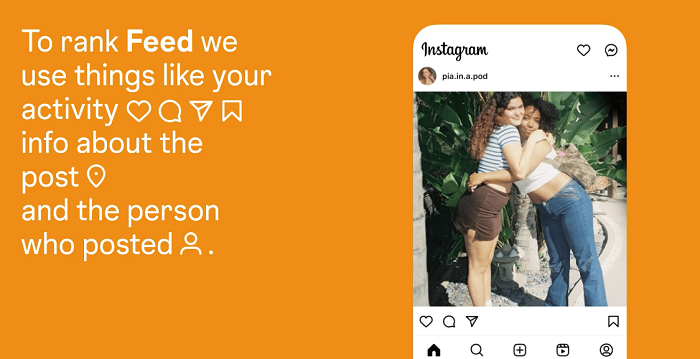
So, as noted, Instagram has increasingly been inserting AI-based recommendations into your feed – which somewhat belies the need for a feed algorithm in the first place (i.e. the algorithm ensures that you see the most relevant content based on who you follow).
Semantics aside, Meta CEO Mark Zuckerberg noted back in April that around 40% of the content displayed in your main IG feed is now fuelled by AI, so a lot of what’s shown here is recommendations from accounts that Instagram thinks you might like, alongside updates from people and profiles you have chosen to follow.
Mosseri says that the four key factors which dictate the ranking of your main Instagram feed are:
- Your activity. Posts you’ve liked, shared, saved or commented on help us understand what you might be interested in.
- Information about the post. These are signals both about how popular a post is – think how many people have liked it and how quickly people are liking, commenting, sharing and saving a post – and more mundane information about the content itself, like when it was posted, and what location, if any, was attached to it.
- Information about the person who posted. This helps us get a sense for how interesting the person might be to you, and includes signals like how many times people have interacted with that person in the past few weeks.
- Your history of interacting with someone. This gives us a sense of how interested you are generally in seeing posts from a particular person. An example is whether or not you comment on each other’s posts.
No surprises there – with the only real revelation being that Instagram has now also started weighting content format more heavily.
“So if we notice you prefer photos, we’ll show you more photos.”
This has been a key pain point for IG, with users often criticizing it for prioritizing video over all else, and it’s hoping to address this by measuring how each user interacts with content in different formats.
In measuring which specific posts to show, Instagram also tries to predict how likely you are to:
- Spend time looking at a post
- Comment on it
- Like it
- Share it
- Visit the creators’ profile
The more likely you are to take one of these actions, the higher up in Feed you’ll see the post.
Mosseri further notes that Instagram tries to avoid showing too many posts from the same person/profile in a row, or too many suggested posts back to back.
Also worth noting – in April last year, Mosseri noted that its algorithms will also prioritize original content.
For the next element, Mosseri also explains how Instagram’s system ranks Stories, and decides which Stories to display, in which order, along the top bar of the app.
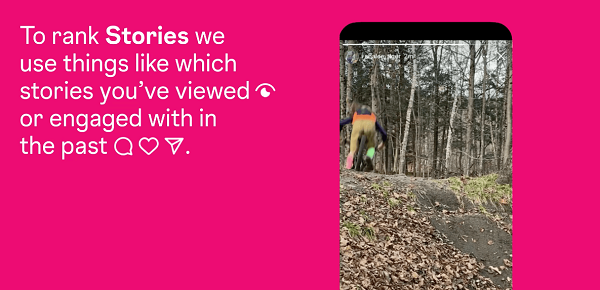
Instagram doesn’t show you AI-based recommendations for Stories (as yet), so the Stories display is ranked based on the content shared by accounts that you follow.
The key ranking considerations for Stories are:
- Viewing history. This looks at how often you view an account’s stories so we can prioritize the stories from accounts we think you don’t want to miss.
- Engagement history. This looks at how often you engage with that account’s stories, such as sending a like or a DM.
- Closeness. This looks at your relationship with the author overall and how likely you are to be connected as friends or family.
Based on these, Instagram’s system then tries to predict how likely you are to tap into a story, or reply to a Story, then ranks the display accordingly.
It’s a bit simpler than your main feed, but there are some relevant notes here to help you better understand how to potentially boost your Stories ranking.
Mosseri also explains how Instagram ranks its Explore page, which is based on overall popularity, how you’ve interacted with similar posts in the past, and whether you’ve engaged with the creator previously.
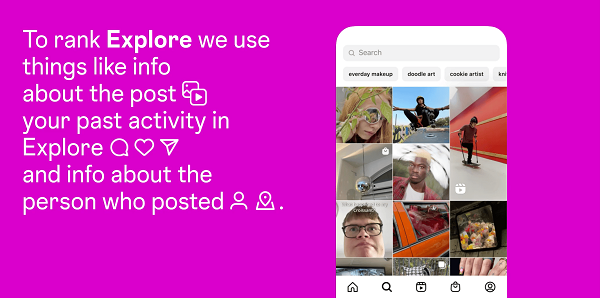
And finally, Reels, which is more influenced, Mosseri says, by entertainment, and how likely you are to find a Reel engaging.
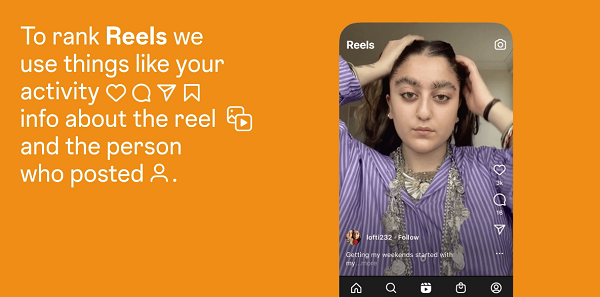
As shown above, the key Reels ranking factors are:
- Your activity. We look at things like which reels you’ve liked, saved, reshared, commented on, and engaged with recently. These signals help us understand what content might be relevant to you.
- Your history of interacting with the person who posted. As with Explore, it’s likely the video was made by someone you’ve never heard of, but if you have interacted with them, that gives us a sense of how interested you might be in what they shared.
- Information about the reel. These are signals about the content within the video such as the audio track or visuals in the video, as well as popularity.
- Information about the person who posted. We consider popularity signals such as the number of followers or level of engagement to help find compelling content from a wide array of people and give everyone a chance to find their audience.
Mosseri also notes that Reels which are watermarked, or captured in low resolution, will get less reach as a result, while Reels that are muted, contain borders, or are mostly text, will also get downranked.
Key points to keep in mind.
Mosseri also says that Reels which focus on political issues won’t get optimal reach. This is part of Meta’s broader push to reduce division and angst caused by political content, based on feedback from users.
Mosseri also provides tips on how users can influence what they see in the app, by using Instagram’s content control options and tools like ‘Favorites’ which will rank posts from certain profiles higher.
Mosseri also addresses the concept of ‘Shaowbanning’, which is a vague concept that’s misunderstood by many.
“Contrary to what you might have heard, it’s in our interest as a business to ensure that creators are able to reach their audiences and get discovered so they can continue to grow and thrive on Instagram. If there is an audience that is interested in what you share, then the more effectively we help that audience see your content, the more they will use our platform.”
Mosseri essentially explains that Shadowbanning, as such, is not a thing, though you will lose reach as a result of violating IG’s guidelines or posting content that goes against the rules. To better address this, Instagram added additional information into its Account Status dashboard last year, which includes info on potential factors that could influence your post reach.
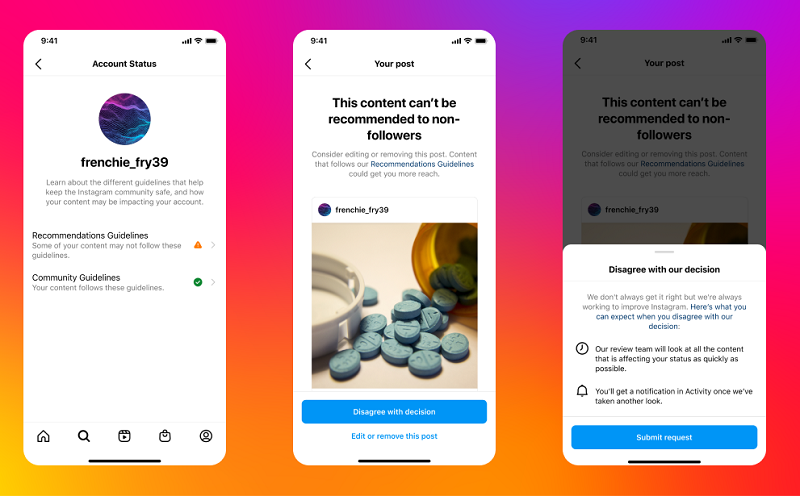
It’s an interesting overview, with a heap of information to take in about how Instagram ranks content. And while there are no major revelations, it is worth noting the various elements, and how they can influence your performance in the app.
You can read Adam Mosseri’s full ranking overview here.



